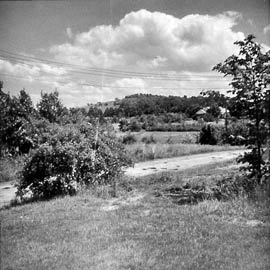THE TOWN OF NORTH GREENBUSH was formed February 23, 1855 when the Town of Greenbush was divided into the towns of East and North Greenbush. It is located along the Hudson River, extending east about five miles. It lies opposite the north part of the City of Albany and immediately south of the City of Troy. Its roots trace back to the colonial Dutch culture of the Rensselaerswyck Patroonship established by Killian Van Rensselaer in the 17th Century when the area was a Dutch colony. The name Greenbush comes from the Dutch “Greenebos,” a term for pine grove. The location opposite Albany and immediately south of Troy defined North Greenbush’s role as first an area crossed by important trade routes, later an agriculture produce supplier, and recently a bedroom community for these urban centers.

towards Bell Top School
North Greenbush is a part of the area comprising the Rensselaerswyck Patroonship established by Killian Van Rensselaer in 1628. Although there is record of settlement along the Hudson in what is now the City of Rensselaer in the mid 17th Century, it is unlikely that there was any extensive settlement in the North Greenbush area until the second third of the 18th Century.
It appears that the initial wave of settlement concentrated in the area closest to the Hudson River, west of what is now Bloomingrove Drive. Until the second third of the 18th Century the threat of attack by hostile Indians deterred settlers from venturing far from the Greenbush settlement located in the vicinity of “Fort Crailo.” With the end of the French and Indian War, the first period of North Greenbush area settlement began.
Blooming Grove (Defreestville) Bath-on Hudson (which later became part of the City of Rensselaer) and Wynantskill were the first communities in what became North Greenbush, and remained the only significant ones until Snyders Lake sprang up in the early 20th Century.

hamlet of Bloomingrove.
Sylvester’s “History of Rensselaer County” reports that David M. DeFreest had an early inn at Blooming Grove about the time of the Revolution. The home of the Reformed Church Dominie serving the Wynantskill and Greenbush Churches was located at Blooming Grove in 1794. A school was begun in 1809 and the Blooming Grove Reformed Church was established in 1814. Blooming Grove was renamed Defreestville about 1830 to avoid confusion with a post office with the same name in Orange County, New York.
Wynantskill was a settlement at least by the late 18th Century. The Wynantskill Reformed Church existed in the 1790s. The Kinney Tavern is reputed to have been in operation by 1802. Rapid growth in the settlement began in the late 19th Century when trolley service provided convenient access to the Troy industrial center.
In 1931 a new Route 4 was built which shifted some through-traffic off the winding residential Bloomingrove Drive. In the 1960s, the Patroon Island Bridge across the Hudson river was constructed as part of the Interstate 90 highway through the area which substantially improved access to the employment centers in Albany, Colonie and Schenectady and linked the town to the interstate highway system.
The immediate future of North Greenbush appears to be dominated by the conversion of farmland to residential and commercial use. The construction of the Rensselaer Technology Park is an embryo for a significant new and different path of development. Since 1983, thirteen buildings have been developed for high-technology based businesses serving both regional and international markets.
(Much of the information for this short history comes from a study of historical structures commissioned by the Town and prepared by former Town Historians Karen Hartgen and Sam Swanson
